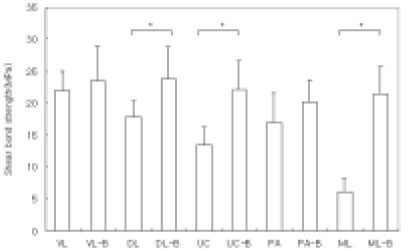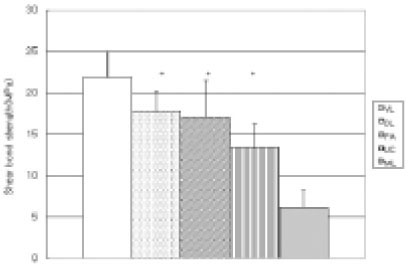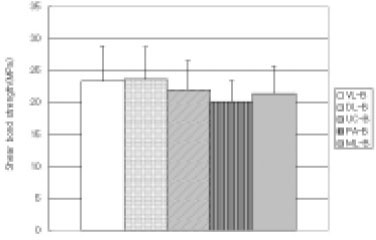Influence of adhesive application on shear bond strength of the resin cement to indirect resin composite
- Affiliations
-
- 1Department of Conservative Dentistry, School of Dentistry, DSRI, Chonnam National University, Korea. hinso@jnu.ac.kr
- KMID: 1986779
- DOI: http://doi.org/10.5395/JKACD.2008.33.5.419
Abstract
- This study analyzed the influence of dental adhesive/primer on the bond strength between indirect resin composite and the resin cement. Seventy disc specimens of indirect resin composite (Tescera Dentin, Bisco) were fabricated. And bonding area of all specimens were sandblasted and silane treated for one minute. The resin cements were used with or without application of adhesive/primer to bonding area of indirect resin restoration: Variolink-II (Ivoclar-Vivadent): Exite DSC, Panavia-F (Kuraray): ED-Primer, RelyX Unicem (3M ESPE): Single-Bond, Duolink (Bisco): One-step, Mulitlink (Ivoclar-Vivadent): Multilinh Primer. Shear bond strength was measured by Instron universal testing machine. Adhesive application improved shear bond strength (p < 0.05). But Variolink II and Panavia-F showed no statistically significant difference according to the adhesive application. With the above results, when resin inlay is luted by resin cement it seems that application of dental adhesive/primer is necessary in order to improve the bond strength.
MeSH Terms
Figure
Cited by 4 articles
-
Effect of curing methods of resin cements on bond strength and adhesive interface of post
Mun-Hong Kim, Hae-Jung Kim, Young-Gon Cho
J Korean Acad Conserv Dent. 2009;34(2):103-112. doi: 10.5395/JKACD.2009.34.2.103.Effect of a desensitizer on dentinal bond strength in cementation of composite resin inlay
Sae-Hee Han, Young-Gon Cho
J Korean Acad Conserv Dent. 2009;34(3):223-231. doi: 10.5395/JKACD.2009.34.3.223.Microtensile bond strength of self-etching and self-adhesive resin cements to dentin and indirect composite resin
Jae-Gu Park, Young-Gon Cho, Il-Sin Kim
J Korean Acad Conserv Dent. 2010;35(2):106-115. doi: 10.5395/JKACD.2010.35.2.106.Shear bond strength of a self-adhesive resin cement to resin-coated dentin
Jee-Youn Hong, Cheol-Woo Park, Jeong-Uk Heo, Min-Ki Bang, Jae-Jun Ryu
J Korean Acad Prosthodont. 2013;51(1):27-32. doi: 10.4047/jkap.2013.51.1.27.
Reference
-
1. O'Brien WJ. Dental materials and their selection. 2002. 3rd ed. Chicago: Quintessence;377.2. Irie M, Suzuki K. Current luting cements; marginal gap formation of composite inlay and their mechanical properties. Dent Mater. 2001. 17:347–353.
Article3. Krämer N, Lohbauer U, Frankenberger R. Adhesive luting of indirect restorations. Am J Dent. 2000. 13:60D–76D.4. Christensen GJ. Acceptability of alternatives for conservative restoration of posterior teeth. J Esthet Dent. 1995. 7:228–232.
Article5. Burke FJ. The effect of variations in bonding procedure on fracture resistance of dentin-bonded all-ceramic crowns. Quintessence Int. 1995. 26:293–300.6. Jensen ME, Sheth JJ, Tolliver D. Etched-porcelain resin-bonded full veneer crowns: in vitro fracture resistance. Compendium. 1989. 10:336–338.7. Jacobsen PH, Rees JS. Luting agent for ceramic and polymeric inlays and onlays. Int Dent J. 1992. 42:145–149.8. Braga RR, Ballester RY, Carrilho MR. Pilot study on the early shear strength of porcelain dentin bonding using dual cure cements. J Prosthet Dent. 1999. 81:285–289.
Article9. Braga RR, Cesar PF, Gonzaga CC. Mechanical properties of resin cements with different activation mode. J Oral Rehabil. 2002. 29:257–262.
Article10. Hahn P, Attin T, Grofke M, Hellwig E. Influence of resin cement viscosity on microleakage of ceramic inlays. Dent Mater. 2001. 17:191–196.
Article11. Kitasako Y, Burrow MF, Katahira N, Tagami J. Shear bond strength of three resin cements to dentin over 3 years in vitro. J Dent. 2001. 29:139–144.
Article12. Sanares AM, Itthagarun A, King NM, Tay FR, Pashley DH. Adverse surface interactions between one-bottle light cured adhesives and chemical cured composites. Dent Mater. 2001. 17:542–556.
Article13. Yanagawa T, Finger WJ. Relationship between degree of polymerization of resin composite and bond strength to Gluma-treated dentin. Am J Dent. 1994. 7:157–160.14. Kelsey WP 3rd, Triolo PT, Blankenau RJ, Kelsey MN, Ortmeier C, Hauser D. Bond strengths to enamel and dentin with indirect and direct resin composites. Am J Dent. 1996. 9:105–108.15. Nikaido T, Nakajima M, Higashi T, Kanemura N, Pereira PN, Tagami J. Shear bond strengths of a single-step bonding system to enamel and dentin. Dent Mater J. 1997. 16:40–47.
Article16. Watanabe EK, Yamashita A, Yatani H, Ishikawa K, Suzuki K. Improvement in the tensile bond strength between resin cement and dentin surfaces after temporary cement application. Int J Prosthodont. 1998. 11:203–211.17. Phrukkanon S, Burrow MF, Tyas MJ. Effect of cross-sectional surface area on bond strengths between resin and dentin. Dent Mater. 1998. 14:120–128.
Article18. Davies B, Dunne SM, Mokhfari M, Nicholson J. A comparison of the shear bond strength of composite resin bonded by a fourth and fifth generation dentin adhesive to bovine teeth. Prim Dent Care. 1999. 6:103–106.19. Mondragon E, Soderholm KJ. Shear strength of dentin and bonded composites. J Adhes Dent. 2001. 3:227–236.20. Inoue S, Vargas MA, Abe Y, Yoshida Y, Lambrechts P, Vanherle G. Microtensile bond strength of eleven contemporary adhesives to dentin. J Adhes Dent. 2001. 3:237–245.21. Suliman JF, Swift EJ Jr, Perdigao J. Effect of surface treatment and bonding agents on bond strength of composite resin to porcelain. J Prosthet Dent. 1993. 70:118–120.
Article22. Roulet JF, Soderholm KJ, Longmate J. Effect of treatment and storage conditions on ceramic/composite bond strength. J Dent Res. 1995. 74:381–387.
Article23. Ozden AN, Akaltan F, Can G. Effect of surface treatments of porcelain on the shear bond strength of applied dual-cure cement. J Prosthet Dent. 1994. 72:85–88.24. Thurmond JW, Barkmeier WW, Wilwerding TM. Effect of porcelain surface treatments on bond strength of composite resin bonded to porcelain. J Prosthet Dent. 1994. 72:355–359.
Article25. Kupiec KA, Wuertz KM, Barkmeier WW, Wilwerding TM. Evaluation of porcelain surface treatments and agents for composite-to-porcelain repair. J Prosthet Dent. 1996. 76:119–124.
Article26. Kamada K, Yoshida K, Atsuta M. Effect of ceramic surface treatments on the bond of four resin luting agents to a ceramic material. J Prosthet Dent. 1998. 79:508–513.
Article27. Madani M, Chu FC, McDonald AV, Smales RJ. Effect of surface treatments on shear bond strengths between a resin cement and an alumina core. J Prosthet Dent. 2000. 83:644–647.
Article28. Della Bona A, van Noort R. Shear vs tensile bond strength of resin composite bonded to ceramic. J Dent Res. 1995. 74:1591–1596.
Article29. Jackson RD, Ferguson RW. An asthetic bonded inlay/onlay technique for posterior teeth. Quintessence Int. 1990. 21:7–12.30. Sheth PJ. Comparative evaluation of three resin inlay techniques: microleakage studies. Quintessence Int. 1989. 20:831–836.31. Craig RG. Vanherle G, Smith DC, editors. Overview of posterior composite resins for use in clinical practice. Posterior Composite Resin Dental Restorative Materials. 1985. St. Paul: 3M Co;199–211.32. Lopes LMP, Leitao JGM, Douglas WM. Effect of a new resin inlay/onlay restorative material on cuspal reinforcement. Quintessence Int. 1991. 22:641–645.33. Kang HS, Choi HY. A Study on the Marginal Leakage of Class II Composite Resin Inlay. J Korean Acad Conserv Dent. 1992. 17:191–205.34. Douglas WH, Fields RP, Fundingsland J. A comparison between the microleakage of direct and indirect composite restorative systems. J Dent. 1989. 17:184–188.
Article35. Kanca J 3rd. Composite resin luting materials: A rationale for the "90s". J Esthet Dent. 1989. 1:105–109.36. Heymann HO. Indirect composite resin veneers: an alternative, Porcelain laminate veneers. 1998. Quintessence books;126–133.
- Full Text Links
- Actions
-
Cited
- CITED
-
- Close
- Share
- Similar articles
-
- Shear bond strength of a self-adhesive resin cement to resin-coated dentin
- The shear bond strength of two adhesives bonded to composite resin and glass ionomer cement restorations
- Bond strength of self-adhesive resin cements to composite submitted to different surface pretreatments
- Effect Of Dentin Desensitizers On Shear Bond Strength Of Resin Cements
- Change in shear bond strength of orthodontic brackets using self-etching primer according to adhesive types and saliva contamination





